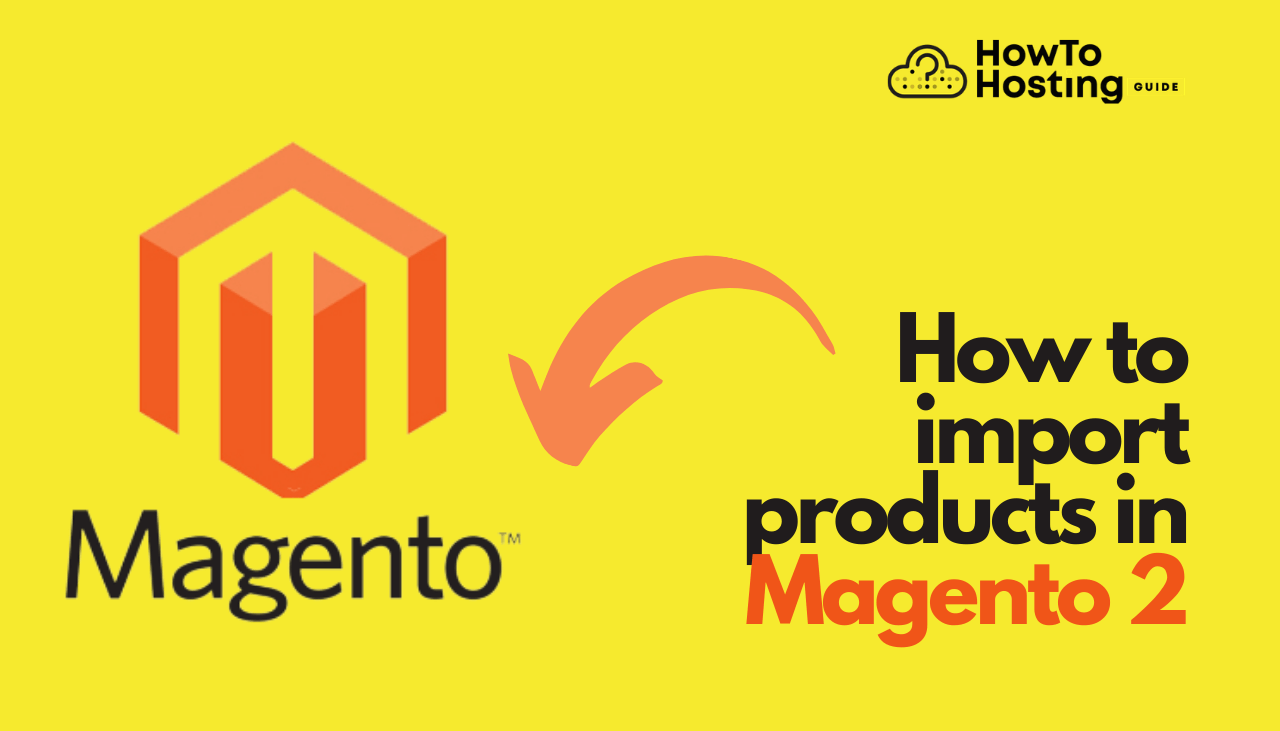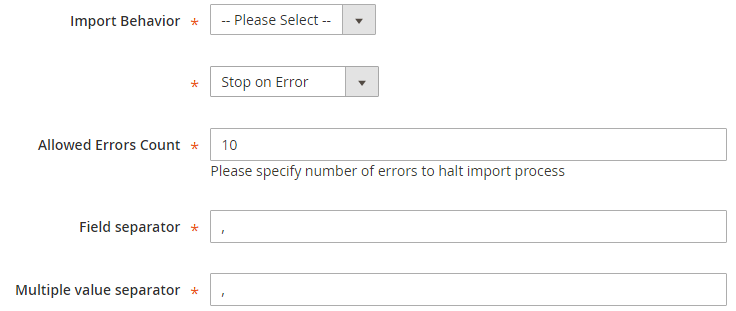On This Page: [hide]
Magento 2 is a CMS platform focused on building online stores and e-commerce websites. It allows you to import data and update your products, replace, delete, and so on. Magento uses CSV files (Comma Separated Value) for its data import, allowing data to be saved in a tabular format. CSVs look like a garden-variety spreadsheet but with a .cvs extension. CSV files can be used with almost any spreadsheet program, such as Microsoft Excel or Google Spreadsheets. In today’s guide, we have prepared instructions on how to import products in your e-commerce Magento 2 website. Let’s get into action!

Related How to Install Magento – Beginner’s Guide
What Are the Types of Products in Magento 2?
There six main types of stock that you can find in any e-commerce website or online store. The usage of a specific stock depends on what you are selling and the type of your store. All of them have a unique SKU (stock-keeping unit). The types have different selling rates, and you can use some of them to increase your online store’s sales.
Type #1 – Simple Products in Magento
The simple product is sold only in one variation, and there are no options to choose between. It is the most popular type of stock on the online stores. It has a fixed size, weight, color, etc.
Example of a simple product.

Type #2 – Configurable Product
The Configurable stock is a combination of simple stocks. It has variations such as color, size, weight, etc. You can choose between the various options that the configurable goods provide. It is also a trendy type of stock in online stores. Most often, the configurable stock is the cloths.
Example of a Configurable Items.
Type #3 – Virtual Product
This type of product is not a physical item. It can’t be shipped or delivered. The Virtual product can be a service, software, subscription, etc., and it can be purchased online but not received as a good.
Example of a virtual product
Type #4 – Grouped Product
The grouped stock, as you can clue from its name, is nothing more a simple or a virtual attribute value, but both share the same characteristics. Most of the types are the same but different colors. Grouped stocks can increase your sales.
Example of a Grouped Stock.
Type #5 – Bundled Product
The bundles are similar to one category that can be put in a combo or bundle. It is a famous selling trick, which can be found in most of the bigger online stores.
Example of a bundled stocks.
Type #6 – Downloadable Product
The downloadable item can be anything that can be download on your computer, such as software, game, file, song, etc.
Example of a downloadable product.
Import Products in Magento 2 – Step Tour
Step #1 – Data Preparation
To start preparing your data first, you need to ensure that the files you are convented to CSV format. Then you need to go to the admin sidebar and choose System –> Data Transfer –> “Import”.
When you are at the importing settings, you need to set the type of product you want to import.
Go to settings and set “Entity Type” to “products.” After this, click “Download Sample File” and then save to start the downloading.
Next, you need to make sure you have confirmed that your import file’s size does not exceed the limit, which is 2MB.
If in your files includes images, make sure that the image files are uploaded to the appropriate location because, by default, they go in pub/media/import.

Step #2 – Import Behavior Configuration
In the behavior section, you need to select the reason for your importing: it can be a new file, update, delete, or replace.
After choosing the import behavior, you need to set the next section to “stop on error.” In the Allowed Errors Count filed, set the number of the error to stop the importing. That is all you need to fill in this section.
Let’s move to the next step.
Step #3 – Import File Identification
Right now, you need to be located in the “select file attachment” section. There click on the “choose file” and choose the file you want to import.
When you are ready with the importing, in the “Images File Directory,” enter the path to the uploaded images on the Magento server, such as “var/import,” or the full URL to the images on another server for example, “http://domain.com/images.”
Step #4 – Check and Validate the Import Process
After completing all the steps up to here, you need to check and validate the process. Click on “Check Data” located on the upper-right corner. Then click import, and when everything is ready, you will receive a message.
Essential Howtohosting.Guide Tips
Tip #1 – Optimize the Images
Before uploading an image, is good to optimize it. It’s good to compress the size of the image and set your domain name in its title.
The “alt” attributes are also important for Goole, by giving the image alt attributes you are telling Google that is about.
Tip #2 – Convert to CSV
To importing files requires the CSV conversion. To convert to CSV you can upload the file to a program that supports this format, just like Exel. Then save the file with CSV format type.
Tip #3: Merge and Minify Your Website CSS and JS
To boost the speed of your store you can merge and minify the CSS and JavaScript of it.
Go to System -> Advanced -> Developer, and set ‘Yes’ to Java Script and CSS files. Save your new store configuration.
Tip #4 – gZIP
To accelerate your website on max you can use gZIP compression.
When the gZip compression is enabled, every page is getting compressed by the server before sending it to the visitor. In this way, when the file arrives, it’s decompressed and displayed on the user’s end.
Also Read Тhe Best Themes for Magento 2
Magento Web Hosting FAQ
What Is Magento Web Hosting?
Magento web hosting refers to a hosting environment explicitly designed to accommodate the unique specifications of the Magento eCommerce platform. This tailored hosting approach ensures that online businesses powered by Magento can operate at peak efficiency, guaranteeing optimal speed, impenetrable security, and high-level scalability to handle surges in web traffic.
Why Do I Need Specialized Hosting for Magento?
Given Magento’s comprehensive and resource-demanding architecture, it becomes imperative to have a hosting environment that’s built to meet its rigorous standards. A specialized Magento hosting ensures that the server settings, configurations, and resources are in harmony with Magento’s requirements, paving the way for smooth operations, faster load times, and fortified security, essential for an online marketplace’s success.
Is Shared Hosting Suitable for Magento?
On the surface, shared hosting may seem like an economical choice for Magento stores. However, because multiple websites share the server resources in such an environment, it can often fall short of delivering the requisite performance metrics for larger Magento-based marketplaces. For businesses that aim for growth, dedicated, VPS, or cloud hosting are generally better suited, offering dedicated resources and enhanced configuration.
How Does SSD Hosting Benefit Magento?
Unlike traditional Hard Disk Drives (HDDs), Solid-State Drives (SSDs) don’t have moving parts and offer rapid data access speeds. Incorporating SSDs in a Magento hosting environment means that website content, especially dynamic content, loads at lightning speed. This not only provides a seamless shopping experience to end-users but also reduces the bounce rate and enhances overall user engagement.
Why Is Caching Important for Magento Hosting?
Caching, at its core, is a mechanism to store and retrieve frequently accessed data without burdening the primary data source repeatedly. In the context of Magento, implementing efficient caching strategies ensures that website pages render faster, system resources are optimally used, and users don’t have to wait long — a crucial factor in retaining potential customers and boosting sales.
How Does a Content Delivery Network (CDN) Benefit Magento Stores?
A Content Delivery Network is essentially a network of servers distributed globally. It functions by storing cached versions of your Magento store’s content in various locations. When a user from, say, Europe accesses your US-based store, the CDN serves content from a European server, drastically cutting down content delivery times. The result? Happier customers, reduced strain on your primary server, and potentially higher conversions.
Are Automatic Backups Essential for Magento?
In the dynamic world of online commerce, safety nets are crucial. Automatic backups serve as this very net, ensuring that if anything goes not according to plan — be it technical glitches, inadvertent human errors, or malicious cyber-attacks — your store’s data remains safe. With periodic automatic backups, you can restore your Magento store to its previous state, ensuring business continuity and safeguarding your reputation.
Do I Need SSL for My Magento Store?
SSL (Secure Socket Layer) isn’t just a recommendation for eCommerce platforms; it’s a necessity. By establishing an encrypted link between your web server and a visitor’s browser, SSL ensures that all data, especially sensitive information like credit card numbers, remains private. Beyond the security benefits, an SSL certificate also fosters trust among your clientele and can offer a slight edge in search engine rankings.
Can I Upgrade My Hosting Plan As My Store Grows?
Growth is the end goal for any business, and in the digital realm, growth often translates to more web traffic. Reputable hosting providers design their plans with scalability in mind, ensuring that as your Magento store expands its footprint, your hosting environment adapts in tandem. Whether it’s more storage, better processing power, or increased bandwidth, a scalable hosting solution will cater to your evolving requirements.
How Do I Choose the Right Magento Hosting Provider?
Choosing the right hosting provider is a decision that can shape the trajectory of your Magento store. While price is an essential factor, equally (if not more) important are aspects like guaranteed uptime (preferably 99.9% or more), stellar customer support, proven server speed and performance metrics, cutting-edge security provisions, and genuine reviews from fellow Magento store owners. Research, compare, and engage in trials if possible, to make an informed choice that aligns with your business aspirations. One recommended method to compare prices and features is to use the smart tool, called Hosting Finder by HTH. It will compare the latest Magento hosting plans and show you the best offers and discounts currently on the market.








Ottima guida, io personalmente faccio anche uso di Feed Manager per uniformare i listini che mi inviano i fornitori. Connecteed mi sta tornando molto utile per gestire i prodotti in modo massivo, voi fate uso di altri gestori di feed? Avete esperienza con l’uso di questi strumenti?
(EN Verson) Excellent guide, I personally also make use of Feed Manager to standardise the price lists that suppliers send me. Connecteed is coming in very handy for me to manage products in bulk, do you make use of other feed managers? Do you have experience with the use of these tools?